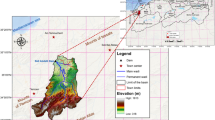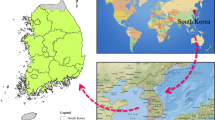Abstract
The capacity of soil and water conservation measures, defined as the maximum quantity of suitable soil and water conservation measures contained in a region, were determined for the Loess Plateau based on zones suitable for establishing terraced fields, forestland and grassland with the support of geographic information system (GIS) software. The minimum possible soil erosion modulus and actual soil erosion modulus in 2010 were calculated using the revised universal soil loss equation (RUSLE), and the ratio of the minimum possible soil erosion modulus under the capacity of soil and water conservation measures to the actual soil erosion modulus was defined as the soil erosion control degree. The control potential of soil erosion and water loss in the Loess Plateau was studied using this concept. Results showed that the actual soil erosion modulus was 3355 t∙km–2∙a–1, the minimum possible soil erosion modulus was 1921 t∙km–2∙a–1, and the soil erosion control degree was 0.57 (medium level) in the Loess Plateau in 2010. In terms of zoning, the control degree was relatively high in the river valley-plain area, soil-rocky mountainous area, and windy-sandy area, but relatively low in the soil-rocky hilly-forested area, hilly-gully area and plateau-gully area. The rate of erosion areas with a soil erosion modulus of less than 1000 t∙km–2∙a–1 increased from 50.48% to 57.71%, forest and grass coverage rose from 56.74% to 69.15%, rate of terraced fields increased from 4.36% to 19.03%, and per capita grain available rose from 418 kg∙a–1 to 459 kg∙a–1 under the capacity of soil and water conservation measures compared with actual conditions. These research results are of some guiding significance for soil and water loss control in the Loess Plateau.
Similar content being viewed by others
References
Angulo-Martínez M, Beguería S, 2009. Estimating rainfall erosivity from daily precipitation records: A comparison among methods using data from the Ebro Basin (NE Spain). Journal of Hydrology, 379(1/2): 111–121.
Bullock A, King B, 2011. Evaluating China’s slope land conversion program as sustainable management in Tianquan and Wuqi counties. Journal of Environmental Management, 92: 1916–1922.
Fu B J, Liu Y, Lu Y H et al., 2011. Assessing the soil erosion control service of ecosystems change in the Loess Plateau of China. Ecological Complexity, 8: 284–293.
Dotterweich M, 2013. The history of human-induced soil erosion: Geomorphic legacies, early descriptions and research, and the development of soil conservation: A global synopsis. Geomorphology, 201: 1–34.
Gao H D, Li Z B, Li P et al., 2012. Quantitative study on influences of terraced field construction and check-dam siltation on soil erosion. Journal of Geographical Sciences, 22(5): 946–960.
Gao H D, Li Z B, Li P et al., 2013. Concept and calculation methods of erosion control degree: A case study of the Wangmaogou watershed. Science of Soil and Water Conservation, 11(1): 17–24. (in Chinese)
Gunther F, Nachtergaele Freddy N, Sylvia P et al., 2008. Global Agro-ecological Zones Assessment for Agriculture (GAEZ 2008). IIASA, Laxenburg, Austria and FAO, Rome, Italy.
Jiang D S, 1997. Soil Erosion and Control Model in the Loess Plateau. Beijing: China Water & Power Press, 106–120. (in Chinese)
Jiao J Y, Wang Z J, Zhao G J et al., 2014. Changes in sediment discharge in a sediment-rich region of the Yellow River from 1955 to 2010: implications for further soil erosion control. Journal of Arid Land, 6(5): 540–549.
Jiao J Y, Zou H Y, Jia Y F et al., 2009. Research progress on the effects of soil erosion on vegetation. Acta Ecologica Sinica, 29: 85–91.
Li L, Zhou Z H, Liu G C, 2005. The present situation and some thoughts of soil loss tolerance study. Advances in Earth Science, 20(10): 1127–1134. (in Chinese)
Li R, Yang W Z, Li B C, 2008. Research Progress and Prospect of the Chinese Loess Plateau. Beijing: Science Press, 183–211. (in Chinese)
Li Z, Zhang Y, Zhu Q K et al., 2015. Assessment of bank gully development and vegetation coverage on the Chinese Loess Plateau. Geomorphology, 228(1): 462–469.
Liu J Y, Kuang W H, Zhang Z X et al., 2014. Spatiotemporal characteristics, patterns, and causes of land-use changes in China since the late 1980s. Journal of Geographical Sciences, 24(2): 195–210.
Liu S L, Wang C, Zhang X L et al., 2011. Soil and water conservation effect of different terrace configurations in land consolidation project. Journal of Soil and Water Conservation, 25(4): 59–68. (in Chinese)
Liu X Y, Wang F G, Yang S T et al., 2014. Sediment reduction effect of level terrace in the hilly-gully region in the Loess Plateau. Journal of Hydraulic Engineering, 45(7): 793–780. (in Chinese)
McCool D K, Foster G R, Mutchler C K et al., 1989. Revised slope length factor for the universal soil loss equation. Transactions of the American Society of Agricultural Engineers, 32: 1571–1576.
Ministry of Public Security Authority of the People’s Republic of China (NBS, PRC), 2013. The National Counties Population Statistics Yearbook 2011. Beijing: Qunzhong Press, 121–219. (in Chinese)
Ministry of Water Resources of the People’s Republic of China (MWR, PRC), Chinese Academy of Sciences, Chinese Academy of Engineering, 2010. Water Loss and Soil Erosion and Ecological Security of China: The Loess Plateau. Beijing: Science Press, 28–59. (in Chinese)
National Bureau of Statistics of the People’s Republic of China, 2012. China County Statistical Yearbook 2012. Beijing: China Statistics Press, 10–426. (in Chinese)
Ran D C, 2006. Water and sediment variation and ecological protection measures in the middle reach of the Yellow River. Resources Science, 28(1): 93–100. (in Chinese)
Renard K G, Foster G R, Gleen W et al., 1997. Predicting soil erosion by water: A guide to conservation planning with the revised universal soil loss equation (RUSLE). In: U.S. Department of Agriculture Agricultural Handbook No. 703. US Department of Agriculture, Washington, DC.
Su C L, Liang Y, Li D C et al., 2011. Concept and evaluation methodology of watershed management and recovery degree in red soil region. Soils, 43(3): 466–475. (in Chinese)
Sun W Y, Shao Q Q, Liu J Y et al., 2014. Assessing the effects of land use and topography on soil erosion on the Loess Plateau in China. Catena, 121: 151–163.
Upper and Middle Reaches of the Yellow River Administrative Bureau, 2011. Introduction to the Soil and Water Conservation of Yellow River Basin. Zhengzhou: Yellow River Water Conservancy Press, 64–96. (in Chinese)
Wang F, Mu X M, Li R et al., 2015. Co-evolution of soil and water conservation policy and human-environment linkages in the Yellow River Basin since 1949. Science of the Total Environment, 508: 166–177.
Williams J R, Jones C A, Kiniry J R et al., 1989. The EPIC crop growth model. Transactions of the ASAE, 32(2): 497–511.
Wu F Q, Zhang Y B, Wang J, 2004. Study on the benefits of level terrace on soil and water conservation. Science of Soil and Water Conservation, 2(1): 34–37. (in Chinese)
Xie H X, 2008. Study on the spatio-temporal change of soil loss and on the assessment of impacts on environment of soil and water conservation in Yanhe basin [D]. Xi’an: Shaanxi Normal University. (in Chinese)
Xie W C, Li T H, 2012. Research comment on watershed sediment delivery ratio. Acta Scientiarum Naturalium Universitatis Pekinensis, 48(4): 685–694. (in Chinese)
Xu J X, Sun J, 2004. Effect of erosion control measures on sediment delivery ratio. Advances in Water Science, 15(1): 29–34. (in Chinese)
Yao W Y, Ran D C, Chen J N, 2013. Recent changes in runoff and sediment regimes and future projections in the Yellow River basin. Advances in Water Science, 24(5): 607–616. (in Chinese)
Yellow River Basin Monitoring Center (YRBMC) of Water-Soil Conservation and Eco-Environment, 2011. The Middle and Upper Reaches of the Yellow River Survey of Soil and Water Conservation Measures. Xi’an: Upper and Middle Yellow River Bureau. (in Chinese)
Yellow River Conservancy Commission of the Ministry of Water Resources, 2013. Yellow River Basin Comprehensive Planning (2012–2030). Zhengzhou: Yellow River Water Conservancy Press, 1–10. (in Chinese)
Zhang H M, Yang Q K, Li R et al., 2013. Extension of a GIS procedure for calculating the RUSLE equation LS factor. Computers & Geosciences, 52: 177–188.
Zhang S J, Jiao J Y, 2011. Soil loss tolerance in the Loess Plateau based on the healthy function of the lower reaches of the Yellow River. Science of Soil and Water Conservation, 9(1): 9–15. (in Chinese)
Zhang X P, Zhang L, Wang Y et al., 2009. Tempo-spatially responses of the annual streamflow to LUCC in the middle reaches of Yellow River, China. Science of Soil and Water Conservation, 7(1): 19–26. (in Chinese)
Zhang Y, Liu B Y, Shi P J et al., 2001. Crop cover factor estimating for soil loss prediction. Acta Ecologica Sinica, 21(7): 1050–1056. (in Chinese)
Zhang Y, Liu B Y, Zhang Q C et al., 2003. Effect of different vegetation types on soil erosion by water. Acta Botanica Sinica, 45(10): 1204–1209.
Zhang Y X, Gao J N, Shao H et al., 2014. The terraced fields environmental impact assessment in data-scarce areas based on the embedded terraced module SWAT model. Nature Environment and Pollution Technology, 13(2): 283–288.
Zheng J Y, Yin Y H, Li B Y, 2010. A new scheme for climate regionalization in China. Acta Geographica Sinica, 65(1): 3–12. (in Chinese)
Zhao L S, Liang X L, Wu F Q, 2014. Soil surface roughness change and its effect on runoff and erosion on the Loess Plateau of China. Journal of Arid Land, 6(4): 400–409.
Zhu T X, 2012. Gully and tunnel erosion in the hilly Loess Plateau region, China. Geomorphology, 153/154: 144–155.
Author information
Authors and Affiliations
Corresponding author
Additional information
Foundation: National Natural Science Foundation of China, No.41401305; No.41330858; The Open Foundation of State Key Laboratory of Soil Erosion and Dryland Farming on the Loess Plateau, No.K318009902-14
Gao Haidong (1983–), PhD, specialized in soil erosion and remote sensing.
Rights and permissions
About this article
Cite this article
Gao, H., Li, Z., Jia, L. et al. Capacity of soil loss control in the Loess Plateau based on soil erosion control degree. J. Geogr. Sci. 26, 457–472 (2016). https://doi.org/10.1007/s11442-016-1279-y
Received:
Accepted:
Published:
Issue Date:
DOI: https://doi.org/10.1007/s11442-016-1279-y




